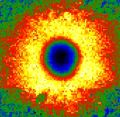Speaker
Description
Perovskite solar cells (PVKSC) are currently being intensively researched due to their promising efficiency in generating electricity from the sun. PVKSCs seem to be a real alternative to classic silicon-based cells. Scientists around the world are trying to modify individual components of perovskite cells to achieve the highest possible efficiency. One of the active substances currently used is formamidinium lead triiodide (FAPbI3) because it provides better thermal stability, has a narrower band gap and less ion migration, resulting in stable modules, which helped them achieve a high-power conversion efficiency of about 25% 1.
An equally important element of solar cells is the layer that ensures the flow of electrons, the so-called Electron Transport Layer (ETL). In our laboratory, as ETL, we tested titanium dioxide (TiO2) layers deposited on glass coated with ITO (indium-tin oxide) using titanium diisopropoxide bis(acetylacetonate) solution in 1-butanol as a precursor/source of titanium. The solution was applied to ITO-coated glass using the spin-coating method. Then the layers were preheated at 200C and then calcined at 500C for 30 min. [2] Depending on the spin speed during precursor application, it was possible to obtain layers of a specific thickness from 5 to 100 nm.
The TiO2@ITO layer is semi-transparent. Its transmittance in the range over 400 nm is about 80%. Depending on the applied potential and wavelength of the incident light, the material generated a photocurrent about a few µA (Fig.1). Therefore, these layers could be used not only in the construction of perovskite solar cells but also for photoelectrochemical and optoelectronic applications as an electron transport layer.[2]

Bibliography:
1. Ch. Zhao et all, „Design of Bridge Molecules for High-Efficiency FAPbI3-Based Perovskite Solar Cells”, ACS Energy Lett. 2024, 9, 1405−1414
2. A. Sławek, Z. Starowicz, M. Lipiński, “The influence of the Thickness of Compact TiO2 Electron Transport Layer on the Performance of Planar CH3NH3PbI3 Perovskite Solar Cells”, Materials, 2021, 14, 3295
Acknowledgments:
NCBR grant: Beyond 27% perovskite solar cells: A deep study based on in-situ charge dynamics and crystal growth kinetics (program: Korea-V4, PVKSC DWN/V4-Korea/2/9/24).

